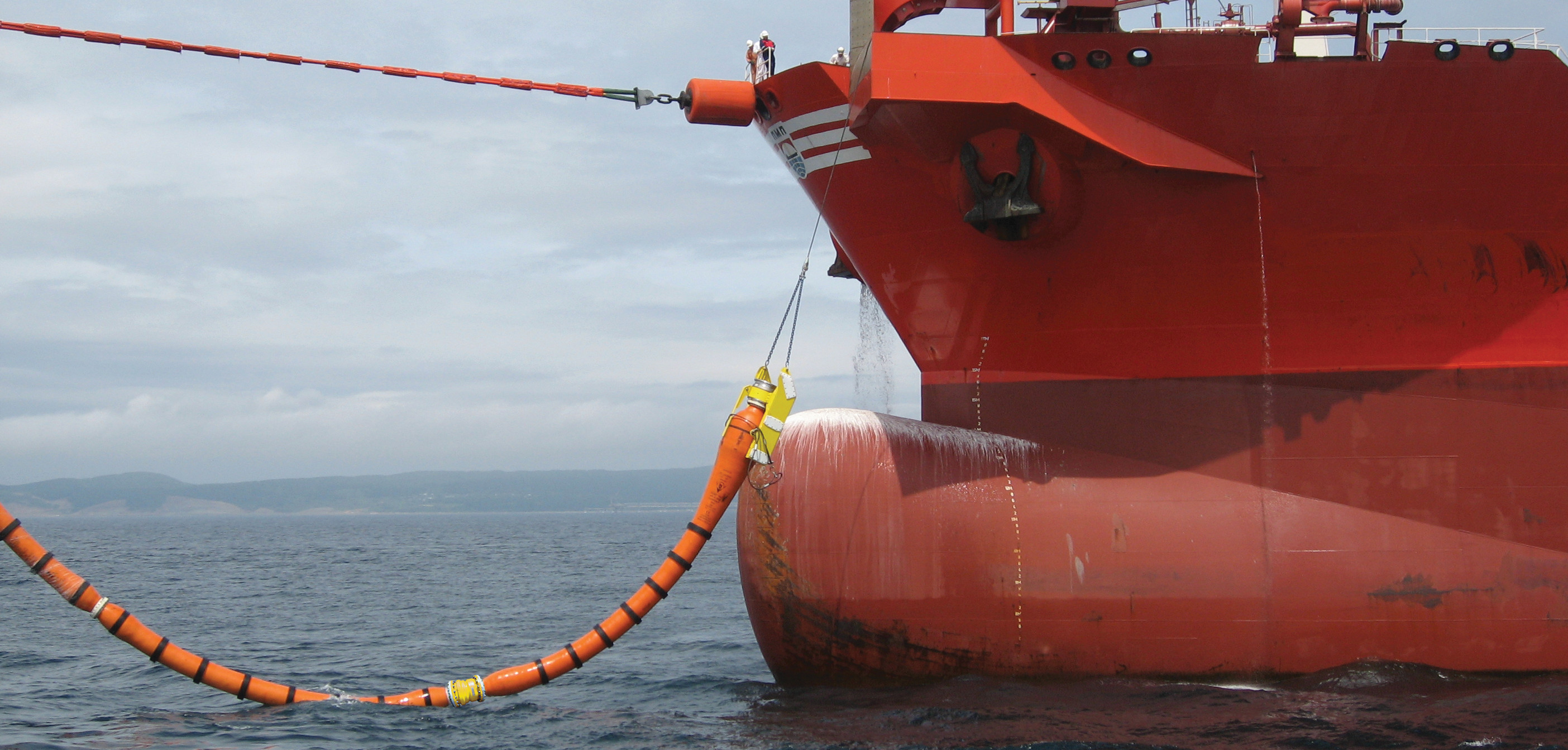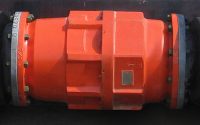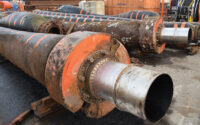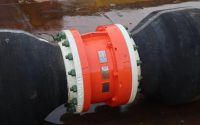Gall Thomson Flip-Flap Marine Breakaway Couplings
This review is of the commonly used Gall Thomson Flip-Flap Valve Marine Breakaway Coupling (MBC).
Application

Shown: Commissioned Gall Thomson Flip-Flap Valve MBC
Hose offshore transfer of low viscosity media between Floating Production Storage and Offloading platforms (FPSOs) and tankers or between tankers or vessels.
Purpose
Gall Thomson Flip-Flap offshore Marine Breakaway Couplings protect a transfer operation in an emergency.
The coupling will automatically activate due to either one end of the line moving beyond a pre-defined distance or because of an unacceptable pressure surge.
Flip-Flap MBCs provide an identified safe parting point in marine hose transfer systems and automatically shut off product flow in the event of an extreme tensile load being applied to the hose string following a tanker breakout, or an excessive pressure surge in the line during tanker loading.
This reduces the risk of damage to assets, injury to personnel and harm to the environment.
Vessel displacement is where the vessel moves beyond the available distance offered by the transfer line. This scenario can occur due to the breaking of moorings in adverse weather conditions, equipment malfunction, human or procedural error.
Pressure surge is typically due to a malfunction of another component within the transfer line.
Without this coupling, stress on the hose caused either by unacceptable movement or pressure surge can result in damage to hoses and other assets, potential injury, extended downtime and spill of media into the environment.
Product profile

Gall Thomson Flip-Flap Valve MBCs deliver 100% leak-tight closure and a totally safe and spill-free separation of the hose transfer system.
Flip-Flap Valve disks are positioned in line with flow. The coupling is parted due to stress on breakstuds causing the combined energy of bias springs and product velocity to flip the disks through a controlled arc and snap onto seats, providing 100% leak-free shut off.
The unit requires no outside power source. This eliminates dependency on other components or mechanisms. It is entirely self-motivated and self-energised, requiring no human intervention.
The shut-off is powered by the energy of the flowing product acting on the valve assembly. The unit is therefore not vulnerable to the reliability of an external power supply.
The Flip-Flap Valve MBC includes springs that ensure valve closure should there be no flow at the time of activation.
The coupling can be re-instated after a breakout or re-installed in a new hose string during a routine change out.
Valve closure can be executed at a controlled rate on the upstream side, or in both directions in the case of a bi-directional flow system. This prevents potential damage to associated equipment including pumps, meters, expansion joints, hoses and gaskets during high velocity transfer.
In certain applications the MBC can be specified to deliver instantaneous shutdown.
The unit is simply bolted between hose joints in the recommended hose string location and requires no commissioning or installation engineer.
Operational loads such as bending movements, torsional stresses and cyclically applied loads created by wave and wind motion, tanker movement and pumping vibration are absorbed and have no adverse effects on function or condition.
Compact and lightweight design means no additional buoyancy aid is required and ensures no detrimental effect on the hose string.
Available in nominal bore sizes of 2″ to 24″.
Typical operational applications
Suitable for marine terminals handling low viscosity products such as kerosene, gasoline, diesel, fuel oils, LPG liquids and vapour or condensate.
Also designed to handle certain light crude oils in systems where the flow rate is relatively low, as well as temporary loading and offloading systems.
- Loading and offloading facilities at SPM (Single Point Mooring) terminals.
- Loading and offloading facilities at CBM (Conventional Buoy Mooring) terminals.
- Selected FSO/FPSO applications.
- Offshore barges, pontoons or other marine terminal applications where low viscosity products are being transferred.
Typical media
Flip-Flap MBCs are ideal for the safe transfer of liquid gases, hazardous chemicals, white oil products, low viscosity and low velocity fuels and short-term crude oil Early Well Test or Early Production Systems.
Performance
Gall Thomson Flip-Flap MBCs are proven as reliable and meet the status of Gall Thomson Field Verified.
Limitations
This Flip-Flap MBC is not usually suitable for high viscosity media.
Cost assessment
Additional costs – servicing
To ensure reliability of breakaway couplings, it is important to adhere to the recommended service schedule. If you currently don’t have a Marine Breakaway Coupling in your transfer line but plan to fit one then expect to integrate its servicing into your maintenance schedule.
Based on normal operating conditions, Gall Thomson Flip-Flap MBCs should be serviced every five years. Expected life is 20 years over three service life cycles.
Potential cost savings compared to alternatives
Because there are no complicated or high maintenance monitoring systems required, Gall Thomson Flip-Flap Valve MBCs offer the optimum solution in protecting hose transfer systems during low viscosity media operations.
No moving parts during normal service eliminates the requirement for maintenance whilst installed in the hose string. The units should be removed for refurbishment at 3-5 year intervals, normally during a hose string change-out.
A well-tried and tested corrosion protection system is applied to the MBC external surface and all internal components are manufactured from stainless steel, ensuring excellent corrosion resistance.
Conclusion
Minimising risk for an operation and undertaking due diligence in protecting the environment is an important objective for modern operations. Gall Thomson Flip-Flap Valve MBCs offer a cost-efficient proven protective solution for operations involved with the transfer of media in an offshore environment.
Further information from supplier: gallthomson.com


